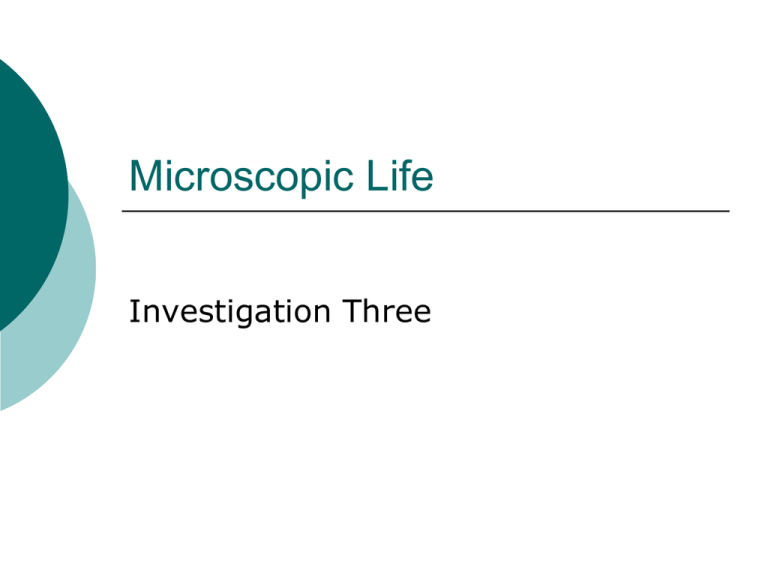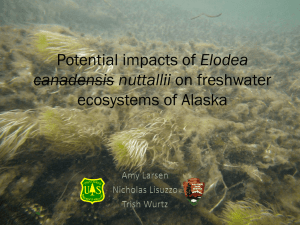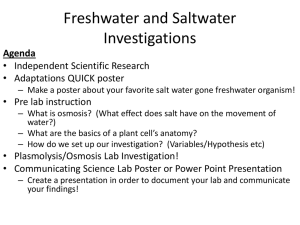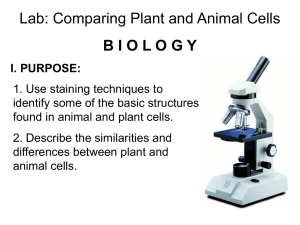Microscopic Life
advertisement

Microscopic Life Investigation Three Elodea Elodea is a aquatic plant. Turn to page 15 in your packet. Read directions. Create a wet mount of the elodea leaf. One person will bring a slide, dropper, coverslip, and forceps to the back counter. Place materials on a paper towel. Identify your pond and place half of an elodea leaf on your slide using the forceps. Add 2-3 drops of pond water and cover slide with a coverslip. Dry, wash and secure all materials. Return to your table. Complete Part 1 and 2. Elodea Discussion Questions 1. What do you see when you look at the Elodea? 2. When you focus up and down through the leaf sample, what did you notice? 3. Are the rectangles flat, like designs drawn on the surface of the leaf, or are they three dimensional? 4. Are the boxes empty? 5. How many layers of these “bricks” do you see? Cell Size 6. What are the boxes or bricks that you see on the Elodea leaf? 7. Are all of the cells on the Elodea leaf the same size? 8. How many layers of cells are there in an Elodea leaf? 9. Are the large cells on the top of the leaf or the bottom? 10. How big are the Elodea cells? 11. Did you notice anything moving inside any of the cells? What did it look like? ELODEA NOTES Cells are the basic unit of life. The boxes or bricks that you see on the Elodea leaf are cells. Cells are the units from which the Elodea leaf is made. Cells are filled with a fluid called cytoplasm. Cytoplasm can sometimes be seen moving inside the cells of living plants. The green balls moving in the cytoplasm are chloroplasts. They give green plants their color. Part 2 and 3 What else was in the elodea slide? Were they alive? What makes you think they are/are not alive? What’s your evidence? What do you think they are? Complete Part 2 and 3 on p. 15. Make sure you write down and draw exactly what you see in the field of view. Discuss observations with table. Wet Mounts of Paramecium View Lab Techniques/CD ROM Bring slide, dropper, cotton ball, and coverslip to the back sink. Work on top of the paper towels, take one drop of pond water and add it to the slide. Pull a few pieces of cotton filament from the cotton ball and place it onto of the pond water. Put coverslip on top and return to your table. Paramecium – single celled What movements did you observe? What did you see on the inside of the paramecium? What did you see on the outside of the paramecium? How big was it at 100x? 400X? Are they living or nonliving? What is your evidence? Could you see if it was doing all of the things you have listed in your definition of a living organism? Did you see it eat or use energy? Give waste? Reproduce? Etc… What might we do to see some of these activities? Elodea vs Paramecia What did the microscopic structure of the elodea look like? What did the microscopic structure of the paramecium look like? Did it look like it was made out of cells? Do the things inside of the paramecium look like the things inside the elodea cells? What were some similarities and differences? Paramecium vs Elodea Facts Paramecia are single celled organisms. Just like the individual green “bricks” in the Elodea are individual cells, each paramecium is an individual cell. The Elodea plant is an organism. It is made of many cells and it is a multicellular organism. The paramecium is an organism. It however, has one cell, single-celled organism. Paramecia and other single celled organisms belong to the kingdom of life called Protista. Some common protist are ameba, euglena, and flagellates. The Elodea plant and the individual paramecium cell are both organisms because they can live on their own. The individual Elodea cell, although it shows signs of life, is not an organism. Evidence: The Elodea cells stay in one place; paramecium move around. Elodea cells are stuck together; paramecium are alone. Elodea cells are part of a bigger organism; paramecium are not. An organism is always free-living. It is not a part of a larger living organism. Characteristics of Cells Cells are alive. Life happens in cells and only in cells. Some cells live alone while others live with millions of others, like the Elodea leaf cells. Not all cells are organisms, because not all cells are able to live independently. An organism, single or multi-celled, can do all characteristics of life.










